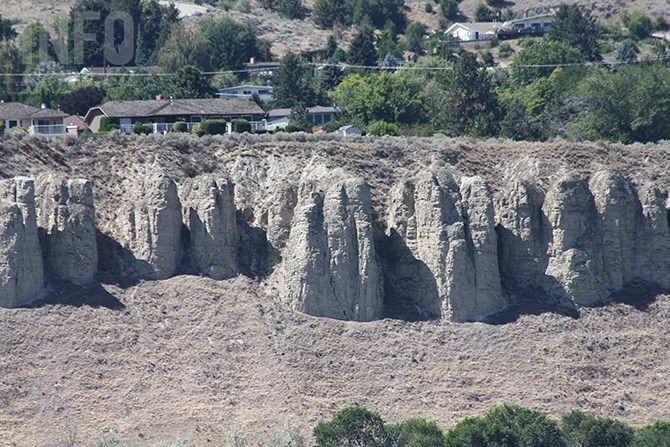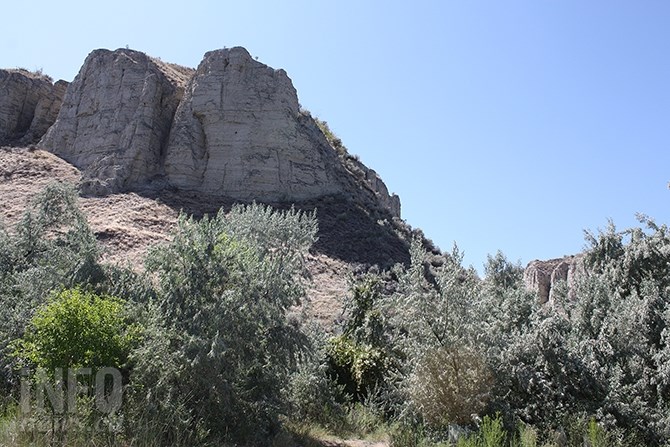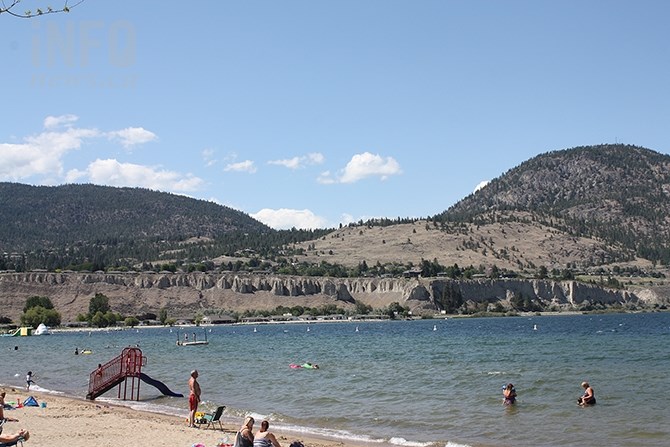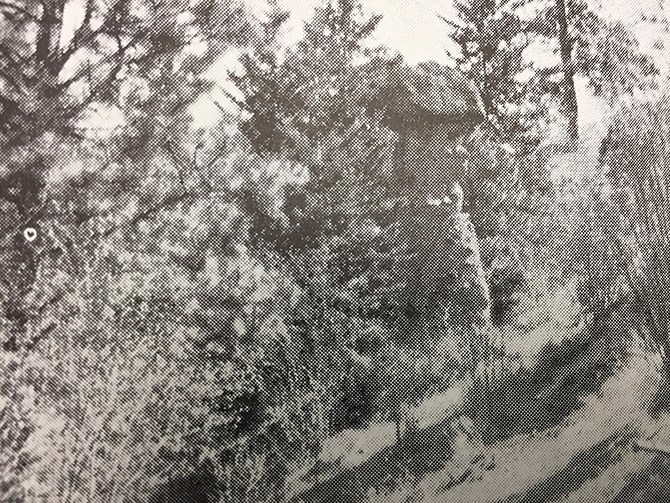
The Okanagan Lake hoodoos just north of Penticton alongside Highway 97.
(STEVE ARSTAD / iNFOnews.ca)
September 07, 2020 - 12:44 PM
PENTICTON - They are an interesting oddity, and a piece of the landscape that becomes indelibly etched in the memory of many tourists who travel Highway 97 north of Penticton.
The Okanagan Lake hoodoos are even more spectacular viewed from Okanagan Lake Beach, lining the cliff face that West Bench is built on, just north of the city.
The clay formations were written about extensively in a tourism book called "Okanagan Valley,” published in 1985 by Heritage House.
“Wind, rain and snow have left myriad forms in their slow and ceaseless sculpturing. Where nature’s heavy tools have been used, the high banks are breached by irregular, winding draws and these in lesser degree by more draws. On exposed points, castellated walls, off-centre pinnacles, roosters’ heads, and strange creatures of the elements’ fancy provide decoration for the impassive mass,” reads a description of the landforms in the book.

Hoodoos of Okanagan Lake.
(STEVE ARSTAD / iNFOnews.ca)
“Considerable mystery is attached to the origin of these attractive bluffs. In the Okanagan valley they are not found south of Okanagan Falls or north of Kelowna,” it continues.
"They seldom show sand or gravel and do not show distinct horizontal banding usually seen in terraces,” was how the book described the formations.
An early geological opinion about the origin of the hoodoos theorized the Pacific Ocean once breached the Coast range, flooding the valley and building fine sediments that built up “white stilts."
The origin of these geological oddities may once have been the subject of conjecture, however, nowadays the most common and accepted theory of their origin is they were formed from lake sediments of ancient Lake Penticton, which was created after the last ice age.
Ian Campbell describes hoodoos as “fantastically shaped, naturally carved rocks or earth pedestals, pillars, or columns” in the Canadian Encylopedia.
He says the name hoodoo comes from voodoo, the West African religion that associates magical powers with natural features.
Hoodoos are formed by the combined erosional forces of wind, rain and running water, along with a variety or physical and chemical weathering process that sculpt the material into different shapes.
One of the oddest hoodoos in the South Okanagan isn’t located along the Okanagan lakeshore, but it is a unique geologic formation that is also culturally significant to the Penticton Indian Band.
Coyote Rock is located in a side valley of the Okanagan, and as odd rock formations go it was perhaps better known to pioneers than present day valley residents.

Hoodoos are formed by erosional action of wind, rain, snow,along with other chemical and physical processes.
(STEVE ARSTAD / iNFOnews.ca)
The location was along the routing of a former community irrigation system, and ditch riders would regularly pass by the rock while inspecting the flumes each summer.
Members of the Okanagan Nation see the geological oddity as a natural shrine, and is a place of religious significance, Penticton Indian Band member Clara Jack said in a 1999 interview.
She said the rock was a marker to First Nations, and talked of a native legend that described its origins.
She said the story described a coyote and beast of some kind that had a big fight in the area. The coyote was torn apart and his body thrown in all directions.
Coyote Rock is what remains of his genitals.
Jack said local First Nations consider it good luck to visit the rock and over the years visited the site to offer prayers, often leaving gifts at its base.
She said in 1999 it was still in use by some members of the band.
As it is a site of reverence to the band, its location remains their privilege to reveal.

Coyote Rock is a geologic oddity not far from the Okanagan Lake hoodoos that has cultural significance to local First Nations.
Image Credit: SUBMITTED
— This story was first published in August 2019.
To contact a reporter for this story, email Steve Arstad or call 250-488-3065 or email the editor. You can also submit photos, videos or news tips to the newsroom and be entered to win a monthly prize draw.
We welcome your comments and opinions on our stories but play nice. We won't censor or delete comments unless they contain off-topic statements or links, unnecessary vulgarity, false facts, spam or obviously fake profiles. If you have any concerns about what you see in comments, email the editor in the link above.
News from © iNFOnews, 2020